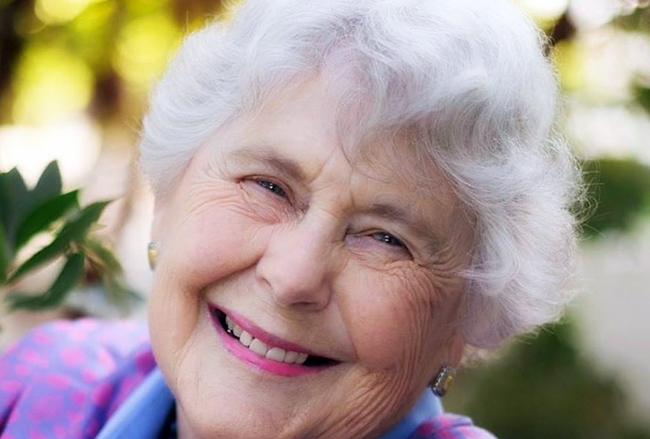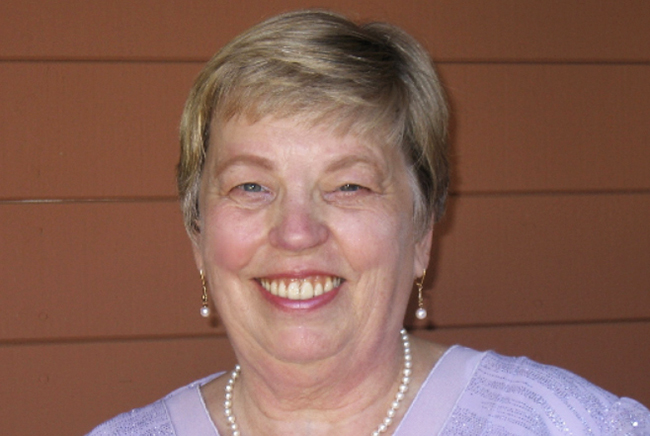Jane Lucile Waters Myers
Dedicated teacher, loving mother, caring sister
Jane Lucile Waters Myers, a longtime Claremont resident, died on March 12, 2014. She was 104 years, 7 months and 12 days old.
She was born in Chino, California on July 26, 1909, the second of eight children, to Arthur Ewing Waters and Eva Laura Mosher Waters. Her father managed a fruit dry-yard and planted fruit trees on his property there.
After three of the children were born, Mr. Waters moved his family to Pomona. There, they owned 53 acres of land, including alfalfa fields, peach trees, apple trees and walnut trees. For the next 10 years, the children were expected to tend the orchards as soon as they were able. Jane’s father woke her before dawn for her morning chores, including milking the family cow.
Mrs. Myers and her siblings spent their days pruning, spraying and irrigating the trees as well as culling, picking and preserving fruit in their dry-yard. To save money, water was piped into the farm during 24-hour stretches. Therefore, irrigation often took place at night, with Jane and her brother Arthur posted on opposite sides of the orchard, signaling with lanterns when the water needed to be channeled to the next furrow. Growing up, Jane attended city schools and graduated from Pomona High School in 1926.
Water was so expensive that the family’s orchards began to lose money. In 1926, Mr. Waters traded the Pomona property for 10 rental bungalows in Glendale. The family moved to a house on Reservoir Street in Pomona. Mr. Waters moved his dry-yard equipment to Hemet, a trading center for crops grown in the San Jacinto Valley. After spending the summer in Hemet, working in their fruit dry-yard, the family returned to Pomona for the school year.
Mr. Waters died from a perforated stomach ulcer in April 1928, leaving the family heartbroken. The coming Depression would be hard for the family, but Mrs. Waters proved to be resourceful. Jane’s mother obtained a teaching job at Pomona High School and bought a small house near the school. After the school year ended, Mrs. Waters took her kids to Hemet so they could work during the fruit-drying season. They camped out in the orchards with the other “migrant workers.”
Salvaging leftover 100-pound flour sacks, sugar sacks and chicken feed sacks, Mrs. Myers and her sisters sewed them together to make one huge cloth. Next to their tent, Jane’s brother Arthur wrapped this cloth around four eight-foot poles. Thus, the family had an enclosure that was open to the sky but provided privacy and protection from the wind. When the other workers in the camp approached, they saw various companies being advertised: “Globe A-1 Flour” for better biscuits, “Spreckels Sweeter than Sweet Sugar” for better cakes and “Lay ‘Em Or Bust” chicken feed for better eggs. Camping mattresses, a gas stove, kerosene lamps plus a cold shower and old-fashioned privy provided by the farm owner completed their accommodations.
Mrs. Myers attended California Christian College in Los Angeles. There, she enjoyed the fellowship of her dorm-mates and, not having to do daily farm work, had the most fun in her life. But one Saturday, her mother—a religious fundamentalist and staunch prohibitionist—came for a surprise visit and found her daughter playing cards with her girlfriends. How the still-teenaged Jane lived through that took some doing.
At CalChristian, Mrs. Myers gained three lifelong friends: Maxine, Frances and Esther. They would pay her a quarter to trim their hair so she would have money to go to a movie with them. One day, the girls and their boyfriends were kidding around on the beach and started tussling. Mrs. Myers, strong from years of farm work, got loose a belt from around one of the guys’ trousers, wrapped it around his ankles and toppled him to the sand. From then on, she was nicknamed “Herk” for “Hercules.”
Mrs. Myers transferred to UCLA, located on Vermont Avenue in Los Angeles at that time. Majoring in physical education, she later attended the present-day UCLA. At that time there was no city of Westwood—just acres of open fields. While going to UCLA and taking teacher-training courses, Jane cooked and cleaned for a family in Hollywood in exchange for room and board. She also worked at several part-time positions to pay for school, and even sent money to her mother to help with her siblings’ expenses.
After Mrs. Myers graduated in June 1932, the Depression forced her to search far and wide for a teaching position. She finally found a job in September 1932, due to a train engine getting buried in a flash flood. She taught 45 students—the children of the work-gang hired to dig out the engine—at an all-grades school in Tehachapi, California, in a temporary structure erected for that purpose.
The next year, she got a job at a one-room school on the Mojave Desert in a canyon called Goler Gulch where she taught for three years, living in a tent-roofed structure. Around this time, Mrs. Myers joined the local chapter of the Philanthropic Educational Organization, which promotes educational opportunities for women. She remained a member for 70 years.
Mrs. Myers became acquainted with the people living in the neighboring town of Johannesburg. One of these was Dwight Myers. They married in June of 1935. Afterwards, Mrs. Myers taught students in a one-room school in nearby Randsburg for two years. She convinced her husband that he should finish his education. To do this, they moved to Golden, Colorado in the fall of 1937.
In those days, married women were not generally hired in Colorado as schoolteachers. While her husband attended college, Mrs. Myers took whatever jobs she could find. She worked as a waitress and was happy to receive a nickel tip. After Mr. Myers graduated, they moved to Leadville, Colorado, high in the Rocky Mountains. During the next three years, Mrs. Myers taught in small nearby mountain towns, one being Stumptown, all located above 10,000 feet.
During World War II, Dwight and Jane lived near Kelso, California, on the Mojave Desert. Then they moved to Washington, DC, where they welcomed a daughter, Della. After the war, they moved to Spokane, Washington. Mrs. Myers got a job teaching at Finch Elementary School there.
Although they did not divorce until August 1964, Dwight and Jane separated in the spring of 1954. Mrs. Myers took Della and moved to California, where she taught at Alcott Elementary School in Pomona for one year.
From 1955 on, for the next 19 years, Mrs. Myers taught elementary school in Claremont, first at Oakmont and then at Chaparral. She especially enjoyed teaching first and second graders, because her 6- and 7-year-old students showed so much enthusiasm for learning. Mrs. Myers purposely wore gaudy pins, because the children loved the sparkly rhinestones. She retired in 1974, after teaching in various places throughout the United States for a total of 33 years.
Mrs. Myers lived for 27 years in the foothills north of Claremont, delighting in the huge oak trees and wildlife there. In 1982, when the property owners, siblings Gwen, Arthur and Jane, decided to put their 40 acres up for sale, they hired a professional to re-survey the land. They soon discovered that in order to do his job, the surveyor would need to make his way through thick underbrush that had grown, unchecked for decades, on the hillsides. It would be a costly endeavor.
Mrs. Myers decided to do the job herself. Dressed in jeans, a long-sleeved shirt, jacket and work gloves, she chopped, sawed, clipped and raked her way through brush that was frequently intertwined with five-foot-tall poison oak bushes. The surveyor was amazed when he found out that Jane had done all of this work—she was 73 at the time.
Mrs. Myers liked going camping, fishing and visiting National and State Parks. She often camped with her siblings at Rock Creek, an ideal trout-fishing spot south of Mammoth, near Tom’s Place. It had quiet pools with large, exposed rocks that sheltered the fish, and there weren’t so many bushes in which lines could get tangled.
In 1982, Mrs. Myers bought a new home in Sun City, California. Her back yard was adjacent to a golf course. Though no longer living in Claremont, she continued to socialize with the Claremont schoolteachers with whom she had forged friendships. Jane also still had the gardening expertise she had acquired during her childhood. She worked hard to transform her clay-hard Caliche soil into suitable, mulch-like dirt for her plants. The golfers often paused to admire her roses, fruit trees, camellias and irises. She never boasted about her green thumb. Her acumen was evident, however, when she had to scramble to find several bunches of suitable homegrown roses—for a PEO event scheduled in the middle of winter.
In 1994, Mrs. Myers moved to her daughter’s home in San Dimas. There, she enjoyed the view of the San Gabriel Mountains and the company of Della’s two cats. She also continued to enjoy reading and gardening. She had learned to play bridge when she was living in Leadville, where snowed-in couples had to create their own entertainment. Now she joined a bridge group comprised of several retired teacher friends and played with them for several years.
In 2008, Mrs. Myers fell and broke her hip. From then on, she resided first in nursing facilities and then in assisted living centers until her death. She is remembered as thoughtful, helpful, reliable and resourceful. She was a loving mother, caring sister and a hard worker who enjoyed remarkable good health for most of her life.
Mrs. Myers is survived by her daughter, Della Myers of San Dimas, and by one of her sisters, Marjorie Newman of Los Osos. A private gravesite service was held for her at Pomona Valley Memorial Park. In lieu of flowers, donations may be made to the charity of your choice.









0 Comments